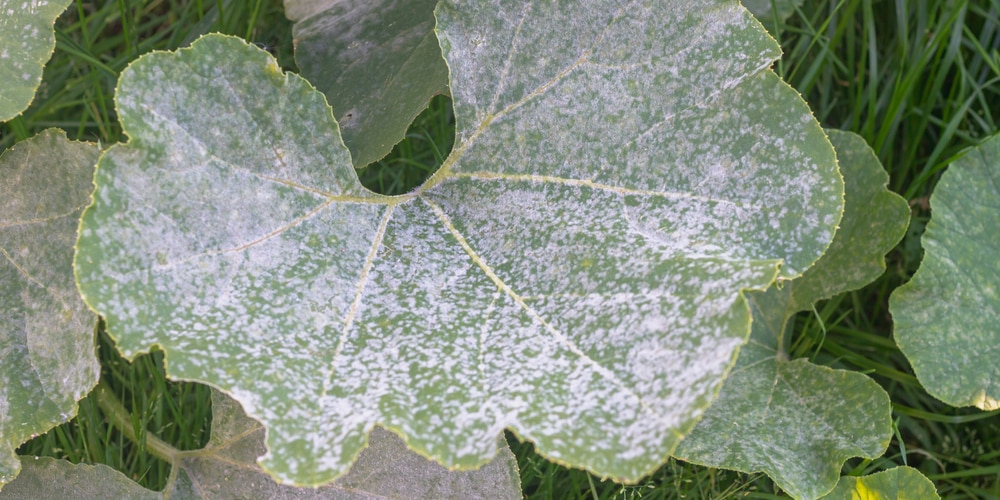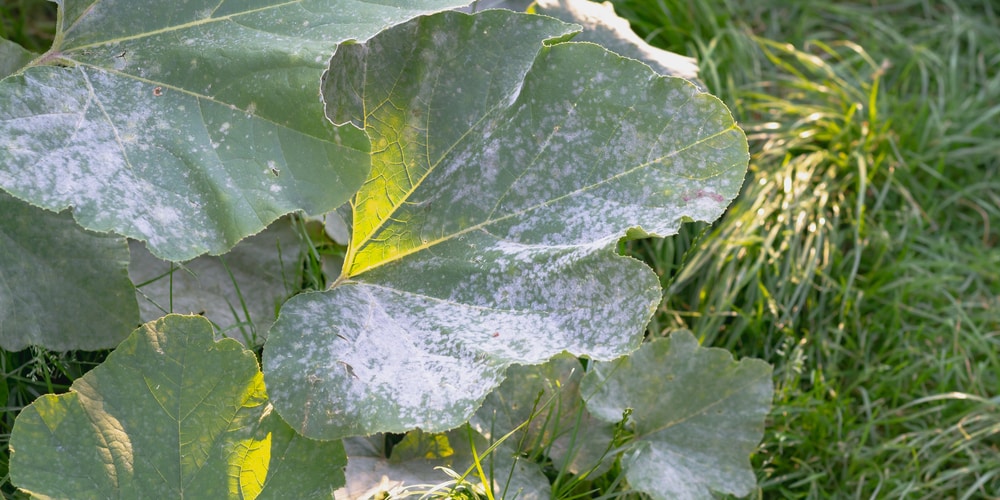White powder on pumpkin leaves is not a good sign! It means that your pumpkin is attacked by powdery mildew, a fungus that can quickly kill plants. To save your pumpkin, you need to take action fast. This article will discuss powdery mildew, how to identify it, and how to get rid of it!
What Causes White Powder on Pumpkin Leaves?

One of the most common problems that can affect pumpkins is powdery mildew. This fungal disease appears as a white, powdery growth on the leaves and stems of the plant. It is most often caused by too little air circulation or too much moisture.
The best way to prevent powdery mildew is to water pumpkins early in the day, so the leaves have time to dry before nightfall. Avoid overhead watering, which can encourage fungus development.
Powdery mildew may develop if you allow infected leaves and stems to remain on the plant. You may also need to use a fungicide on the plant.
Is Powdery Mildew Dangerous
Powdery mildew may look harmless, but this fungal disease can wreak havoc on your plants. Often appearing as a white or gray powder on leaves and stems, powdery mildew spreads quickly and can soon cover an entire plant.
While powdery mildew does not usually kill plants outright, it can cause them to lose leaves and become stunted. The fungus also interferes with a plant’s ability to photosynthesize, which can weaken the plant and make it more susceptible to other diseases. In severe cases, powdery mildew can even kill plants.
If you suspect your plant has powdery mildew, it is essential to take action immediately. Remove any affected leaves and treat the plant with a fungicide. With prompt treatment, you can often save your plant from the damaging effects of this fungal disease.
Treatment Options For Powdery Mildew
If you think your plant has powdery mildew, here are your options for treatment:
Remove infected parts of the plant.
One of the first things you can do is remove any affected leaves or stems. This will help to slow the spread of the fungus.
Treat with a fungicide.
Fungi are notorious for their ability to develop resistance to chemicals, and the fungi that cause powdery mildew are no exception. They are so good at it that fungicides used to control the disease effectively can quickly become useless. This is why experts recommend alternating between two fungicides with a different mode of action (FRAC codes) as frequently as every ten days—or even using two different fungicides simultaneously. This helps prevent the fungi from developing resistance and keeps your plants healthy. So if you’re dealing with powdery mildew, follow these expert recommendations.
Organic remedies
Several organic remedies can be effective against powdery mildew. One popular option is to mix one milk with nine parts of water and spray it on the affected leaves. You can also make a fungicide by mixing two tablespoons of baking soda with one gallon of water. Add a few drops of dish soap to help the solution stick to the leaves. Spray the affected leaves thoroughly and repeat until the powdery mildew is gone every week or so.
Prevention Is The Best Medicine
The best way to get rid of powdery mildew is to prevent it from happening in the first place. Start by planting disease-resistant varieties of pumpkins. When choosing your plants, look for ones labeled “powdery mildew resistant.” These varieties have been bred more resistant to the fungus that causes powdery mildew.
You can also take steps to improve air circulation around your plants. Good air circulation helps to reduce the humidity that powdery mildew needs to thrive. To improve air circulation, make sure to space your plants properly when you plant them. You should also avoid overcrowding your pumpkin patch. If you have too many plants growing close together, it will be harder for air to circulate between them.
Another way to reduce the risk of powdery mildew is to water your plants early in the day. This gives the leaves time to dry off before nightfall. Nighttime is when the fungus that causes powdery mildew thrives. If you water your plants in the evening, the leaves will stay wet overnight, which will create a perfect environment for powdery mildew to develop.
Infected gardening tools can also spread powdery mildew. If you think your tools may be infected, clean them with a solution of one bleach to nine parts water. This will kill the fungus and prevent it from spreading to other plants.
You can also use a fungicide to prevent powdery mildew from developing. There are many different fungicides available, so be sure to read the label carefully to choose one that is right for your pumpkin plants. Apply the fungicide according to the directions on the label.
White Powder on Pumpkin Leaves: Conclusion
To sum it up, the white powder on pumpkin leaves is most likely caused by powdery mildew. While it doesn’t usually kill the plant, it can make it produce fewer fruits or vegetables.
To get rid of powdery mildew, use a fungicide or try home remedies like baking soda or vinegar. You can also take preventative measures like planting resistant varieties or keeping your plants healthy.
Whatever method you choose, be sure to act quickly once you see the powdery mildew so that it doesn’t have a chance to spread.
